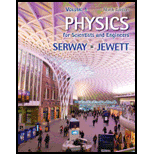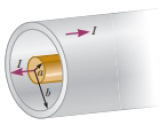
Concept explainers
Review. The use of superconductors has been proposed for power transmission lines. A single coaxial cable (Fig. P31.47) could carry a power of 1.00 × 103 MW (the output of a large power plant) at 200 kV, DC, over a distance of 1.00 × 103 km without loss. An inner wire of radius a = 2.00 cm, made from the superconductor Nb3Sn, carries the current I in one direction. A surrounding superconducting cylinder of radius b = 5.00 cm would carry the return current I. In such a system, what is the magnetic field (a) at the surface of the inner conductor and (b) at the inner surface of the outer conductor? (c) How much energy would he stored in the magnetic field in the space between the conductors in a 1.00 × 103 km superconducting line? (d) What is the pressure exerted on the outer conductor due to the current in the inner conductor?
Figure P31.47

(a)
Answer to Problem 32.75AP
Explanation of Solution
Given info: The power carry by the coaxial cable is
Formula to calculate the current flow in the coaxial cable is,
Here,
Substitute
Thus, the current flow in the coaxial cable is
Formula to calculate the magnetic field at inner conductor from Ampere’s law is,
Here,
Substitute
Conclusion:
Therefore, the magnetic field at the surface of the inner conductor is
(b)
Answer to Problem 32.75AP
Explanation of Solution
Given info: The power carry by the coaxial cable is
Formula to calculate the magnetic field at inner surface of outer conductor from Ampere’s law is,
Here,
Substitute
Conclusion:
Therefore, the magnetic field at the surface of the inner conductor is
(c)
Answer to Problem 32.75AP
Explanation of Solution
Given info: The power carry by the coaxial cable is
Formula to calculate the energy density store in magnetic field is,
Formula to calculate the total energy stored in the magnetic field in the space between the conductors is,
Here,
Write the expression for the small arbitrary volume.
Here,
Formula to calculate the magnetic field from Ampere’s law is,
Substitute
Integrate the above equation within limits.
Substitute
Conclusion:
Therefore, the energy that stored in the magnetic field in the space between the conductors is
(d)
Answer to Problem 32.75AP
Explanation of Solution
Given info: The power carry by the coaxial cable is
The magnetic field created by the inner conductor exerts a force of repulsion on the current in the outer sheath. The strength of this magnetic field is calculated in part (b) that is
Write the expression for the projection area of the outer conductor.
Write the expression for the circumferential area of the outer conductor.
Formula to calculate the current flow in the outer cylinder is,
Here,
Substitute
Substitute
Formula to calculate the force experience by the outer conductor is,
Formula to calculate the pressure exerted on the conductor due to the current is,
Substitute
Substitute
Conclusion:
Therefore, the pressure exerted on the conductor due to the current in the inner conductor is
Want to see more full solutions like this?
Chapter 32 Solutions
Physics for Scientists and Engineers, Volume 1
- If speed is tripled, how much larger will air drag become for an object? Show the math.arrow_forwardWhat does it tell us about factors on which air drag depends if it is proportional to speed squared?arrow_forwardWhat is the net charge on a sphere that has the following? x (a) 5.75 × 106 electrons and 8.49 × 106 protons 4.39e-13 What is the charge of an electron? What is the charge of a proton? C (b) 200 electrons and 109 protons 1.60e-10 What is the charge of an electron? What is the charge of a proton? Carrow_forward
- A spider begins to spin a web by first hanging from a ceiling by his fine, silk fiber. He has a mass of 0.025 kg and a charge of 3.5 μC. A second spider with a charge of 4.2 μC rests in her own web exactly 2.1 m vertically below the first spider. (a) What is the magnitude of the electric field due to the charge on the second spider at the position of the first spider? 8.57e3 N/C (b) What is the tension in the silk fiber above the first spider? 0.125 How does the electric field relate to the force? How do you calculate the net force? Narrow_forwardPoint charges of 6.50 μC and -2.50 μC are placed 0.300 m apart. (Assume the negative charge is located to the right of the positive charge. Include the sign of the value in your answers.) (a) Where can a third charge be placed so that the net force on it is zero? 0.49 m to the right of the -2.50 μC charge (b) What if both charges are positive? 0.185 xm to the right of the 2.50 μC chargearrow_forwardc = ad Find the electric field at the location of q, in the figure below, given that q₁ = 9₁ = 9₁ = +4.60 nC, q=-1.00 nC, and the square is 20.0 cm on a side. (The +x axis is directed to the right.) magnitude direction N/C ° counterclockwise from the +x-axis 9a % 9 9barrow_forward
- Plastic beads can often carry a small charge and therefore can generate electric fields. Three beads are oriented such that 92 is between q₁ and 93. The sum of the charge on 9₁ and 92 is 9₁ + 92 = −2.9 µС, and the net charge of the system of all three beads is zero. E field lines 93 92 What charge does each bead carry? 91 92 -1.45 What is the net charge of the system? What charges have to be equal? μC 2.9 ✓ What is the net charge of the system? What charges have to be equal? μC 93 2.9 μεarrow_forwardA spider begins to spin a web by first hanging from a ceiling by his fine, silk fiber. He has a mass of 0.025 kg and a charge of 3.5 μC. A second spider with a charge of 4.2 μC rests in her own web exactly 2.1 m vertically below the first spider. (a) What is the magnitude of the electric field due to the charge on the second spider at the position of the first spider? 8.57e3 N/C (b) What is the tension in the silk fiber above the first spider? 0.275 How does the electric field relate to the force? How do you calculate the net force? Narrow_forwardPlastic beads can often carry a small charge and therefore can generate electric fields. Three beads are oriented such that 92 is between 91 system of all three beads is zero. E field lines 91 92 93 X What charge does each bead carry? 91 = 92 = ?2.9 0 μC × What is the net charge of the system? What charges have to be equal? μC 93 2.9 με and 93. The sum of the charge on 91 and 92 is 91 +92 = -2.9 μC, and the net charge of thearrow_forward
- An electron has an initial speed of 5.26 x 100 m/s in a uniform 5.73 x 105 N/C strength electric field. The field accelerates the electron in the direction opposite to its initial velocity. (a) What is the direction of the electric field? opposite direction to the electron's initial velocity same direction as the electron's initial velocity not enough information to decide × What is the direction of the force on the electron? How does it compare to the direction of the electric field, considering the sign of the electron's charge? (b) How far does the electron travel before coming to rest? 0.0781 × What kinematic equation is relevant here? How do you calculate the force due to the electric field? m (c) How long does it take the electron to come to rest? 5.27e8 What is the final velocity of the electron? s (d) What is the electron's speed when it returns to its starting point? 5.26e6 m/sarrow_forward(a) What magnitude point charge creates a 90,000 N/C electric field at a distance of 0.235 m? 5.53e-7 C (b) How large is the field at 22.2 m? 9e4 Using the equation for the electric field due to a point charge, and knowing the charge from part (a), can you solve for the field? N/Carrow_forwardNo chatgpt pls will upvote Already got wrong chatgpt answerarrow_forward
 Principles of Physics: A Calculus-Based TextPhysicsISBN:9781133104261Author:Raymond A. Serway, John W. JewettPublisher:Cengage Learning
Principles of Physics: A Calculus-Based TextPhysicsISBN:9781133104261Author:Raymond A. Serway, John W. JewettPublisher:Cengage Learning Physics for Scientists and EngineersPhysicsISBN:9781337553278Author:Raymond A. Serway, John W. JewettPublisher:Cengage Learning
Physics for Scientists and EngineersPhysicsISBN:9781337553278Author:Raymond A. Serway, John W. JewettPublisher:Cengage Learning Physics for Scientists and Engineers with Modern ...PhysicsISBN:9781337553292Author:Raymond A. Serway, John W. JewettPublisher:Cengage Learning
Physics for Scientists and Engineers with Modern ...PhysicsISBN:9781337553292Author:Raymond A. Serway, John W. JewettPublisher:Cengage Learning Physics for Scientists and Engineers: Foundations...PhysicsISBN:9781133939146Author:Katz, Debora M.Publisher:Cengage Learning
Physics for Scientists and Engineers: Foundations...PhysicsISBN:9781133939146Author:Katz, Debora M.Publisher:Cengage Learning
 Glencoe Physics: Principles and Problems, Student...PhysicsISBN:9780078807213Author:Paul W. ZitzewitzPublisher:Glencoe/McGraw-Hill
Glencoe Physics: Principles and Problems, Student...PhysicsISBN:9780078807213Author:Paul W. ZitzewitzPublisher:Glencoe/McGraw-Hill





